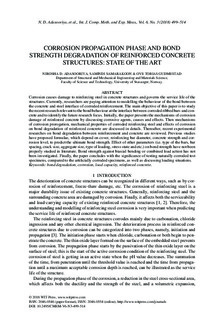| dc.contributor.author | Adasooriya, Mudiyan Nirosha Damayanthi | |
| dc.contributor.author | Samarakoon, Mudiyansele Samindi Manjula K | |
| dc.contributor.author | Gudmestad, Ove Tobias | |
| dc.date.accessioned | 2018-06-21T10:53:12Z | |
| dc.date.available | 2018-06-21T10:53:12Z | |
| dc.date.created | 2018-01-01T23:06:40Z | |
| dc.date.issued | 2018 | |
| dc.identifier.citation | Adasooriya, N.D., Samarakoon, S., Gudmestad, O.T. (2018) Corrosion propagation phase and bond strength degradation of reinforced concrete structures: state of the art. International Journal of Computational Methods & Experimental Measurements, 6(3), pp. 499-514. | nb_NO |
| dc.identifier.issn | 2046-0546 | |
| dc.identifier.uri | http://hdl.handle.net/11250/2502480 | |
| dc.description.abstract | Corrosion causes damage to reinforcing steel in concrete structures and governs the service life of the structures. Currently, researchers are paying attention to modelling the behaviour of the bond between the concrete and steel interface of corroded reinforcement. The main objective of this paper is to study the recent research relevant to the bond behaviour at the interface between corroded ribbed bars and concrete and to identify the future research focus. Initially, the paper presents the mechanisms of corrosion damage of reinforced concrete by discussing corrosive agents, causes and effects. Then mechanisms of corrosion prorogation, mechanical properties of corroded reinforcing steel and effects of corrosion on bond degradation of reinforced concrete are discussed in details. Thereafter, recent experimental researches on bond degradation between reinforcement and concrete are reviewed. Previous studies have proposed formulae, which depend on cover, reinforcing bar diameter, concrete strength and corrosion level, to predict the ultimate bond strength. Effect of other parameters (i.e. type of the bars, bar spacing, crack size, aggregate size, type of loading, stress state and etc.) on bond strength have not been properly studied in literature. Bond strength against biaxial bending or combined load action has not been investigated. Finally, the paper concludes with the significance of testing naturally corroded test specimens, compared to the artificially corroded specimens, as well as discussing loading situations. | nb_NO |
| dc.language.iso | eng | nb_NO |
| dc.publisher | WIT Press | nb_NO |
| dc.relation.uri | https://www.witpress.com/elibrary/cmem/6/3/1995 | |
| dc.subject | bond degradation | nb_NO |
| dc.subject | corrosion | nb_NO |
| dc.subject | korrosjon | nb_NO |
| dc.subject | load capacity | nb_NO |
| dc.subject | reinforced concrete | nb_NO |
| dc.title | Corrosion propagation phase and bond strength degradation of reinforced concrete structures: state of the art | nb_NO |
| dc.type | Journal article | nb_NO |
| dc.type | Peer reviewed | nb_NO |
| dc.description.version | publishedVersion | nb_NO |
| dc.rights.holder | © 2018 WIT Press, www.witpress.com | nb_NO |
| dc.subject.nsi | VDP::Teknologi: 500 | nb_NO |
| dc.source.pagenumber | 499-514 | nb_NO |
| dc.source.volume | 6 | nb_NO |
| dc.source.journal | International Journal of Computational Methods & Experimental Measurements | nb_NO |
| dc.source.issue | 3 | nb_NO |
| dc.identifier.doi | 10.2495/CMEM-V6-N3-499-514 | |
| dc.identifier.cristin | 1533356 | |
| cristin.unitcode | 217,8,5,0 | |
| cristin.unitname | Institutt for maskin, bygg og materialteknologi | |
| cristin.ispublished | true | |
| cristin.fulltext | original | |
| cristin.qualitycode | 1 | |
